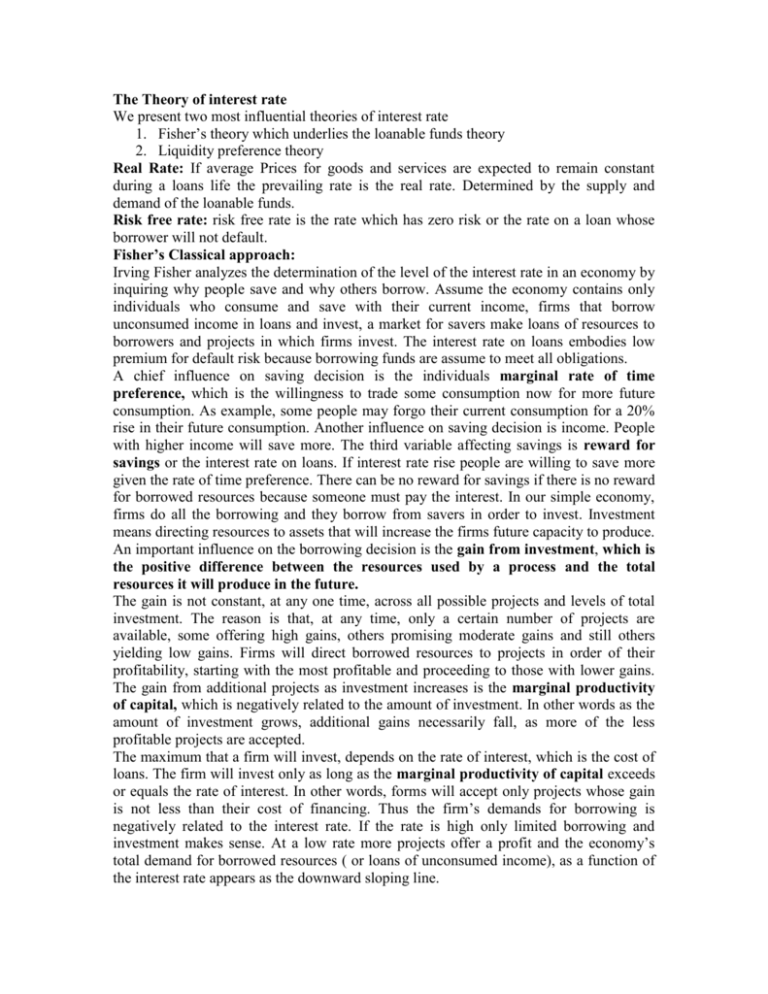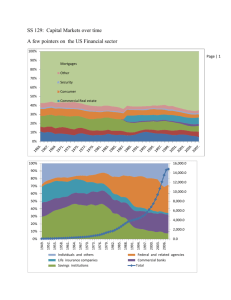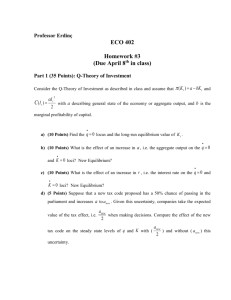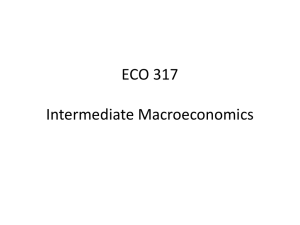The theory of interest rate
advertisement

The Theory of interest rate We present two most influential theories of interest rate 1. Fisher’s theory which underlies the loanable funds theory 2. Liquidity preference theory Real Rate: If average Prices for goods and services are expected to remain constant during a loans life the prevailing rate is the real rate. Determined by the supply and demand of the loanable funds. Risk free rate: risk free rate is the rate which has zero risk or the rate on a loan whose borrower will not default. Fisher’s Classical approach: Irving Fisher analyzes the determination of the level of the interest rate in an economy by inquiring why people save and why others borrow. Assume the economy contains only individuals who consume and save with their current income, firms that borrow unconsumed income in loans and invest, a market for savers make loans of resources to borrowers and projects in which firms invest. The interest rate on loans embodies low premium for default risk because borrowing funds are assume to meet all obligations. A chief influence on saving decision is the individuals marginal rate of time preference, which is the willingness to trade some consumption now for more future consumption. As example, some people may forgo their current consumption for a 20% rise in their future consumption. Another influence on saving decision is income. People with higher income will save more. The third variable affecting savings is reward for savings or the interest rate on loans. If interest rate rise people are willing to save more given the rate of time preference. There can be no reward for savings if there is no reward for borrowed resources because someone must pay the interest. In our simple economy, firms do all the borrowing and they borrow from savers in order to invest. Investment means directing resources to assets that will increase the firms future capacity to produce. An important influence on the borrowing decision is the gain from investment, which is the positive difference between the resources used by a process and the total resources it will produce in the future. The gain is not constant, at any one time, across all possible projects and levels of total investment. The reason is that, at any time, only a certain number of projects are available, some offering high gains, others promising moderate gains and still others yielding low gains. Firms will direct borrowed resources to projects in order of their profitability, starting with the most profitable and proceeding to those with lower gains. The gain from additional projects as investment increases is the marginal productivity of capital, which is negatively related to the amount of investment. In other words as the amount of investment grows, additional gains necessarily fall, as more of the less profitable projects are accepted. The maximum that a firm will invest, depends on the rate of interest, which is the cost of loans. The firm will invest only as long as the marginal productivity of capital exceeds or equals the rate of interest. In other words, forms will accept only projects whose gain is not less than their cost of financing. Thus the firm’s demands for borrowing is negatively related to the interest rate. If the rate is high only limited borrowing and investment makes sense. At a low rate more projects offer a profit and the economy’s total demand for borrowed resources ( or loans of unconsumed income), as a function of the interest rate appears as the downward sloping line. Equilibrium in the market The equilibrium rate of interest is determined by the interaction of the supply and demand functions. As a cost of borrowing, and a reward for lending, the rate must reach the point where total supply of savings equals total demand for borrowing, and investment. Figure 1, shows that this equilibrium rate of interest labeled i, occurs at the intersection of supply and demand curves, D and S. The equilibrium level of savings(which is the same as the equilibrium level of borrowing and investment) is given as SI. Clearly Fisher’s Theory emphasizes that long run level of the interest rate and the amount of investment depend on societies propensity to save and on technological development. Let us now consider the effects of a sudden increase in technological capability, which makes production cheaper. With no change in any other relevant variable, lower production cost mean more gain on investment, and a higher marginal productivity of capital. The resulting increase in firms, desired investment and borrowing through loans at any level of interest rates, is actually an upward shift in the demand function, as shown in figure 2. That shift ( from D to D*) prompts a rise in the equilibrium interest rate, from i to i*, and increase in equilibrium borrowing, and investment from SI to SI*. Now consider circumstances where individuals suddenly grow more willing to save which amounts to a fall in the marginal rate of time preference. All other economical consideration stay the same. As figure 3 depicts this change. The supply of loans function would shift downward from S to S* and savings would be higher at every level of the interest rate. The equilibrium interest rate would also fall, from i to i*. total investment would rise from SI to SI*,a s firms would get more funds and more projects would be profitable at any interest rate. The real rate and the nominal rate It is useful here to distinction between the nominal rate of interest and the real rate of interest. The real rate is the growth in the power to consume over the life of a loan. The nominal rate of interest by contrast, is the number of monitory units to be paid per unit borrowed and is in fact, the observable market rate on a loan, in the absence of inflation, The nominal rate equals the real rate. Because we assume in our discussion that, the purchasing power of the monetary units in a loan stays the same over the loans life, the equilibrium interest rate we have discussed both the nominal and the real rate of interest. In the presence of inflation, however, the nominal rate is different from and must exceed the real rate. The reason is that savers demand a premium above the real rate as compensations for the expected loss in the purchasing power of their interest and their principle. The relationship between the inflation and interest rates is the well known Fisher’s law which can be expressed in this way, (1+i) = (1+r) × (1+p) ………………(1) Where i is the nominal rate, r is the real rate, p is the expected percentage change in the price level of goods and services over the loans life. Equation 1 shows that the nominal rate i reflects both the real rate and expected inflation. Also the compensation demanded by savers applies to both the interest payment and the principle because the left hand side variable is 100% + the interest rate, or the full loan + its interest. Equation 1 can be simplified to a formula i = r + p The only quantities from equation 1 not present in equation 2 are the values of 1,which cancel 1 another out and the product of r and p, which is small enough to be ignored. For example, if the real rate is 3% or 0.03, and the expected inflation rate is 5% or 0.05, their product equals only 0.0015 , or 0.15 of 1% . it is important to realize that expected rate of inflation and real rate are not observable. With fairly good estimates of expected inflation p, it is possible to get a reasonable estimate of r from the nominal rate. But the precise value of the real rate must remain elusive.







